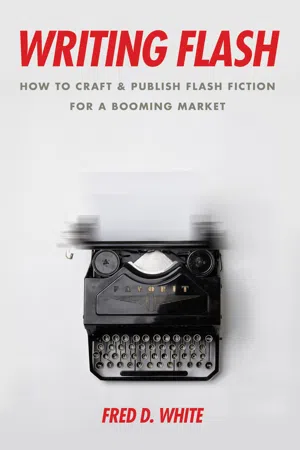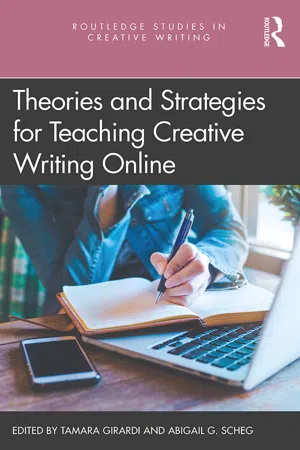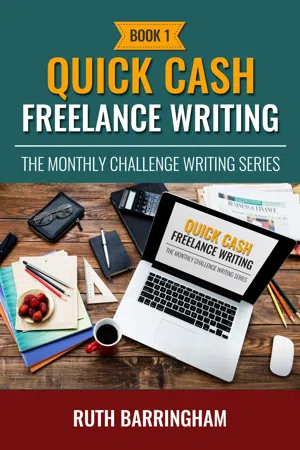Flash Fiction
Flash fiction is a very short form of storytelling characterized by its brevity, typically ranging from 300 to 1000 words. It aims to convey a complete narrative or idea in a compact space, often focusing on a single character or moment. This concise style challenges writers to convey depth and emotion within a limited word count.
4 Key excerpts on "Flash Fiction"
- eBook - ePub
Writing Flash
How to Craft and Publish Flash Fiction for a Booming Market
- Fred White(Author)
- 2018(Publication Date)
- Quill Driver Books(Publisher)
...Flash Fiction is a good way to go rogue artistically. In this chapter, I will introduce you to the different varieties of Flash Fiction to give you a sense of the range of its possibilities. In Chapter 3 I will focus on the techniques of analyzing flash stories in each of these categories, because analytical skills are an important means of augmenting creative skills. Then, in Chapters 4 – 7, I will take you through a step-by-step procedure for writing a flash story in each of those categories. Be sure that you complete at least some of the exercises at the end of each chapter. You will then be ready to submit your stories to journal editors for possible publication; Chapters 8 and 9 will show you exactly how to do that. Literary Flash I: Character Emphasis Describing a story as “literary” means that it is more concerned with conveying subtleties of human behavior in the context of a compelling predicament, employing time-honored literary devices like irony and symbolism—devices, by the way, that poets typically rely on. Indeed, the distinction between literary Flash Fiction and prose poetry is rather blurry. Readers turn to literary fiction to gain insight into, and appreciation of, what it means to be human, how human beings can deal with adversity, how they’re able to cope with the mistakes they’ve made. Literary Flash Fiction is no different, except that it aims to transmit its purpose in no more than 1000 words. It is, quite frankly, a daunting challenge—some might even argue that it’s impossible. The first question that likely springs to mind is, Why not use all the words one can to tell the story? What is so great about restricting the story’s length to a thousand or fewer words? The answer is that the more concentrated something is, the more radiant it can be. Think of the element carbon: one of its manifestations is coal; another, the result of stupendous subterranean pressures, is diamond...
- Tamara Girardi, Abigail G. Scheg, Tamara Girardi, Abigail G. Scheg(Authors)
- 2021(Publication Date)
- Routledge(Publisher)
...In many cases, flash can be much shorter than this limit, even as brief as one sentence. Although many claim that the shorter a story, the easier it is to write, Ketaki Latkar’s Free Press Journal article shines light on what it really means to comprise a well-constructed piece of flash: The operative words for the genre are short and snappy, and getting it right is no mean job. The writing … banks entirely on the element of appeal in the shortest span of time and the choice of the most appropriate set of words, of course, without the loss of emotion and essence. (2018) While novelists have hundreds of pages in which to build a plot and develop character relationships, flash authors use strict decision-making skills to fit those elements into “the shortest span.” In a world where Twitter is king and your average reader is hit with short bursts of text, both for informational and entertainment purposes, it is no surprise that literature is following suit. Of course, people still read and write novels, but the fact that extremely short stories are gaining prevalence is no coincidence. This is neither positive, nor negative; it just is. What is positive about this movement, however, is that authors specializing in flash master some of the most difficult authorial responsibilities that writers face. Due to the shortened nature of these texts authors must capture brevity, causing them to get to the heart of their story, and stay there. In this genre, there is no room for extraneous language or story elements. Everything a flash writer uses is necessary and serves a purpose. This gives the writing a raw, authentic feeling that people get during real life experiences. Much like other societal trends requiring immediate satisfaction and completion, readers consume these stories within minutes...
- eBook - ePub
A Writer's Craft
Multi-Genre Creative Writing
- Kendall Dunkelberg(Author)
- 2017(Publication Date)
- Bloomsbury Academic(Publisher)
...With such restrictions there is little room to do anything more than suggest an argument, so typically the flash piece is short on rhetoric and long on revelation. The flash writer dwells in concrete and specific detail, and the essay or story must grab the reader’s attention in the very first sentence and sustain that level of intensity through the closing word. There is precious little time for explanation or contemplation, as the writer lays down one perception after another, suggesting an interpretation but rarely verbalizing it. As in the poem or in Flash Fiction, the goal is to say as much with as few words as possible and to rely as much on what isn’t said as what is. Yet length is not the only thing that distinguishes flash nonfiction. It is also distinguished by intensity. The flash essay isn’t usually a fragment of a longer piece; instead, it attempts to accomplish everything that a memoir or essay does on a smaller canvas. The scene and the tensions of the piece must be established immediately, and those tensions play out quickly and dramatically. As in poetry, there is often more emphasis on the sound and texture of the language. Sentence structure and the flow of sentences across a paragraph are also important when every word counts. As in Flash Fiction, the essential structure of a story and the suggestion of a character from the smallest details can give the essay life. Like the lyric essay, flash nonfiction can make use of the white space between paragraphs to suggest what hasn’t been revealed and leap from one experience to the next with few or no transitions. Though this may lead to a conclusion that is open-ended and fragmentary, there is, nonetheless, some sense of closure. In this case, readers don’t feel they’ve been given only part of the equation; instead, they are left pondering the fragmentary nature of some truths. Truth in Nonfiction Creative nonfiction shares many qualities with the other genres we are studying...
- eBook - ePub
- Ruth Barringham(Author)
- 2021(Publication Date)
- Ruth Barringham(Publisher)
...Chapter 5. Story Time In this chapter we’re going to look at telling stories. Short fiction can be found in a lot of publications and on many websites. And it’s all different kinds of stories and plenty of different markets. Such as women’s magazines, children’s magazines, short story magazines, fiction websites and even writing competitions, which we’ll discuss more later. One of the more popular stories are ‘twist in the tale’ where there is an unexpected, yet completely plausible, surprise at the end. And the emphasis here is ‘plausible’. But what you write a story about depends completely what your target publication is looking for. The length of stories can vary greatly as well. Story lengths vary from Flash Fiction of 200 words or less, to short stories of up to 1,000 words, and serial fiction which is usually longer stories of 2,000 to 3,000 words each. There is also other short fiction of 5,000 to 10,000 words. Of course the payment for fiction varies a lot too, But don’t think that the longer the story the more it pays because it doesn’t always work like that. Sometimes it does if the payment is by word, and even that can be from 1 cent per word to 20 cents or more. My first success with short fiction was a 1,000 word story that was published in a British magazine and they paid me 300 British pounds which translated to nearly 600 of my Australian dollars. Not bad for a newbie like I was back then, and it really spurred me on to write even more. It’s easy to find markets for short fiction and there are quite a few websites that publish short stories including horror stories, science fiction, romance and crime mysteries. Once you start searching you’ll find plenty more markets...



